Late July inevitably guarantees heat, humidity, and afternoon thunderstorms across the South. Atlanta’s Oakland Cemetery still has plenty of colors to be appreciated by anyone willing to sweat a little. Opened in 1850, the cemetery was born from the national trend of making cemeteries more like parks, where families visit often and create gardens. Today, the Historic Oakland Foundation seeks to preserve and restore the structures, monuments, and gardens. This involves preserving original plant materials planted by families, reintroducing historically appropriate plants, and serving as a site to save plants threatened by development at other sites.
On this day, a rainbow of crepe myrtles (Lagerstroemia indica) continues its long display, showering the ground with a confetti of color, loosened from the previous day’s storm. Across the gardens, white panicled hydrangeas (Hydrangea paniculata) are at their peak. Bright white pointed puffs adding a bright contrast to the collage of greens from the many species of trees.
The browned tips of the bearded iris leaves are the only reminder of last season’s brilliant spring blooms. Summer welcomes a new wave of brightly colored geophytes that paint the garden in a warm palette of yellows, oranges, reds, and pinks. Unfazed by the heat, they have planned well in advance, storing enough energy in their swollen root structures to bloom during the hottest months of the year.
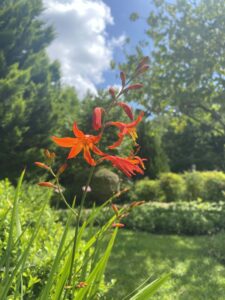
A clump of demure yellow gladiolus is finishing their bloom and have managed to stay upright because of their smaller blooms and shorter stalks. A member of the Iridaceae (Iris) family, their corms are not proficient at keeping large-flowered hybrids upright. The topmost flowers on the stalk are the only blooms left, the rest having finished and withered. Crocosmia (Crocosmia × crocosmiiflora), is another corm in the Iris family that manages to stay erect with support from the dense foliage of an heirloom chrysanthemum neighbor. At first glance, the small flowers appear simply orange, but closer inspection reveals an ombre from yellowish-orange, in the throat, fading to a deep orange boarding on vermillion at the tepal tips. One flower splay houses a minuscule spider, nearly invisible except for the glittering silk strands of the web.
Without a supporting neighbor, another vibrant polka-dotted Irid has overextended itself reaching for the sun and now hovers just above the ground, the leopard lily or blackberry lily.
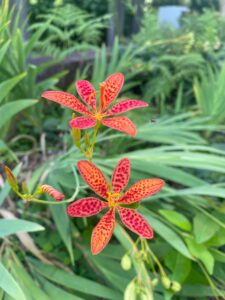
Like so many other plants, it is called a lily but is part of the Iridaceae clan. Reclassified in 2005 from Belamcanda to the Iris genus, it now sports the new name Iris domestica. Not a common plant in commercial trade, but a sturdy heirloom well suited to the South. It is easy to see why they are likened to a leopard. The flowers have all the ostentation of a leopard, but marry that with a palette of orange, crimson, and soft red. Somehow, they still manage to appear elegant with smooth rounded tepals (the botanical term used when petals and sepals are indistinguishable) and an open arrangement. Their color can vary from plant to plant, but the one observed sported three slightly larger tepals with a background of orange and crimson spots. The base color of the other three tepals was a rosy red with larger spots of crimson. Individual flowers only bloom for one day, and then tightly twist closed resembling a spring. As the seeds develop, they form a large seed pod that eventually dries and unwraps to reveal a cluster of black seeds that look like a blackberry, hinting at their other common name.
Unconcerned with strong winds, a row of very tall Autumn Minaret daylilies (Hemerocallis ‘Autumn Minaret’) has thrown up hundreds of six-foot tall blooms. This daylily was introduced in 1951 by A.B. Stout. It gets its height from the species daylily H. altissima which is nearly as tall, pure yellow in color, fragrant, and curiously only opens at night. No doubt its pollinator must be a moth of some sort. Autumn Minaret is said to be lightly fragrant, but not on this day in the heat of mid-day, perhaps in the evening.
A reliably fragrant bloom is not far away though. Crinum ‘Ellen Bosanquet’ pumps out spicy fragrance all day, though I’m sure it is even more seductive in the evening. The smell is not the only alluring quality of this popular crinum, her color is a deep pinkish-burgundy, making me wish I had a glass of pinot noir. Louis Bosanquet hybridized this crinum in Florida around 1920 and named it after his wife. Crinums grow from large bulbs and reside in the Amaryllis family, Amaryllidaceae. There are two other pink flowering bulbs in bloom that are commonly referred to as lilies but are also part of the Amaryllis family, Pink Rain Lily and Surprise Lily.
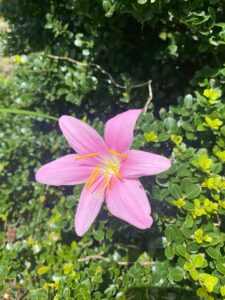
The smaller of these two bulbs is the Pink Rain Lily or Zephyranthes grandiflora. A single two-inch wide pink bloom was sticking its head out of a small shrub, petals coaxed open flat by the sun. The oval tepals are a rosy pink that fade to white and then citron green in the throat. Observed at peak, the pointy anthers were plump with bright yellow pollen, beautifully contrasted against the pink petals. It earns its specific epithet grandiflora because its flower is definitely larger than its white flowering cousin, Z. candida, which was also blooming. Rain lilies are native to the Americas and start blooming in July with increased rain and continue into autumn. The pink form is tropical and technically tender in Atlanta. This particular bulb must have found a microclimate, by a grave marker and protected under a shrub, because it is highly unlikely someone planted one or two bulbs under an evergreen shrub.
Another of the pink bulbs is the Surprise Lily or Lycoris squamigera. So named because the inflorescence emerges without leaves and is often only noticed when the flowers open. Where nothing was the day before, suddenly there is a cotton candy pink umbel atop a two-foot stem. The site is quite surprising, indeed. This is generally the first Lycoris to bloom here in Atlanta. Scattered across Oakland Cemetery there were blooms just past peak while others were still emerging, ensuring a long display. From afar they look like cotton candy on child-height scapes, ready for the picking. Unopened blooms are magenta contrasting nicely with the softer pink opened blooms. Closer inspection reveals tips that are tinged with blue and as if dusted with glitter, the tepals sparkle in the sunlight. Inside the trumpet, the soft pink fades to a warm yellow. Small scales line the inside of the trumpet and account for its botanical species name, squamigera, which translates to scaly or scale-bearing. George Rodgers Hall, of Rhode Island, traveled, lived, and gardened in both China and Japan in the mid-1800s. He collected art and plants and is credited with introducing them to the United States in 1861 sending bulbs to Francis Parkman Jr. in Boston, Massachusetts. Because the leaves do not emerge until spring, unlike its red cousin Lycoris radiata which sets leaves after flowering, squamigera is able to survive in much colder climates, up into New England. It does not prefer the deep South, so L. radiata and L. aurea are two alternatives to try in zones 9 and 10.
Growing alongside the pink Surprise Lilies the first blooms were opening on a true lily, the Formosa Lily or Lilium formosanum. They grow quite tall, 4 to 7 feet, with several blooms per stem. Juvenile blooms start out pointed skyward. As they develop to maturity, the peduncle becomes a contortionist arching the bud into a backbend to face the ground. On one stem three buds had drooped, leaving one bud still standing erect. The buds swell and eventually open to reveal an elegant white trumpet. Unsatisfied with beauty alone, it also tempts visitors with a sweet fragrance. Despite its large flowers towering on a thin stem, they are very sturdy and usually require no support. The stem is densely covered with thin pointed leaves from ground to flower which is distinct from most other lilies.
The Formosa Lily originates from Taiwan which was previously known as Formosa. This name originated from Portuguese sailors in 1544 who gave it the island the name Ilha Formosa translating to Beautiful Island. After blooms fade the ovaries swell, holding many flat disk-shaped seeds. The peduncle rights itself back to a vertical position along with the seed pod. In late fall, the dried stem resembles a candelabra, the three to four inch pods the candlesticks. Eventually, the pods unfurl, starting from the top, slowly releasing seeds into the breeze. They provide great sculptural interest all through winter, a lovely reminder of summer in the dead of winter. Additionally, they are striking in dried floral arrangements or wreaths, persisting for years indoors.
Another lily was finishing up its performance, the Black Beauty Lily (Lilium ‘Black Beauty’). Each stem is branched with dozens of blooms, on this day the final few blooms at the top were just past peak. Its cranberry-colored tepals were fully recurved, defined with a white margin, and punctuated by a green center extending out into a point. The result is a central green star. Strongly fragrant, they would make excellent cut flowers and perfume the largest of rooms.
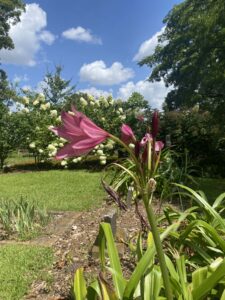
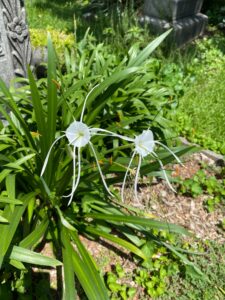

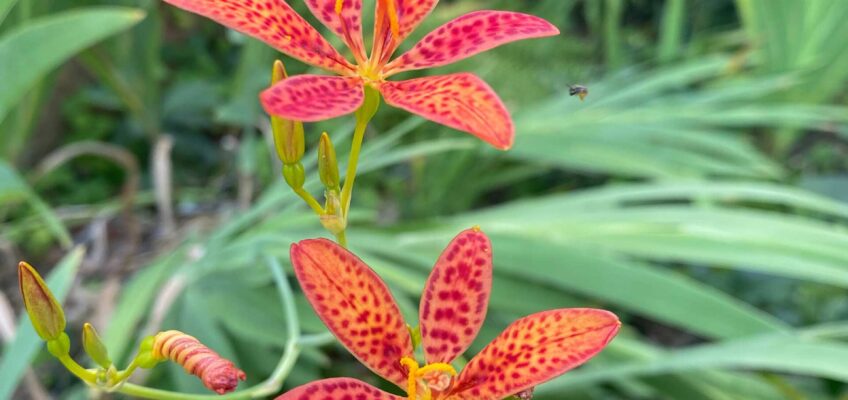
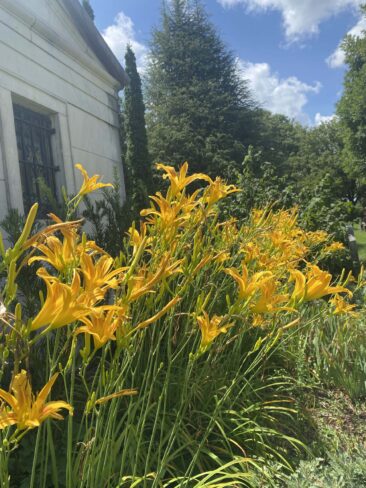

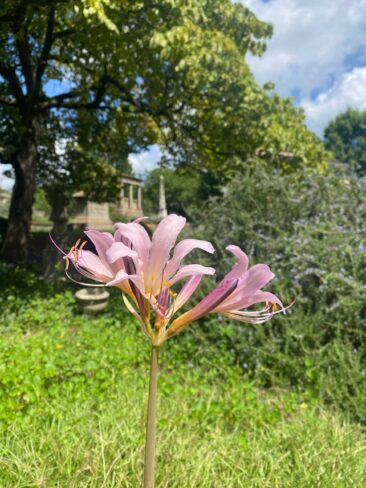
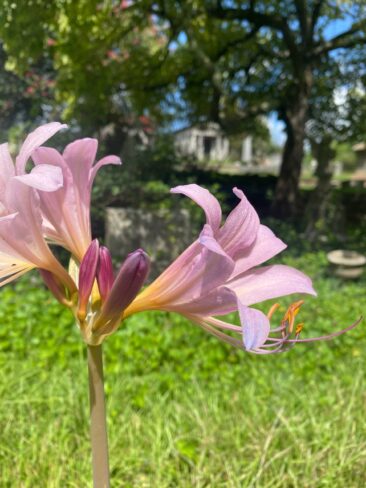
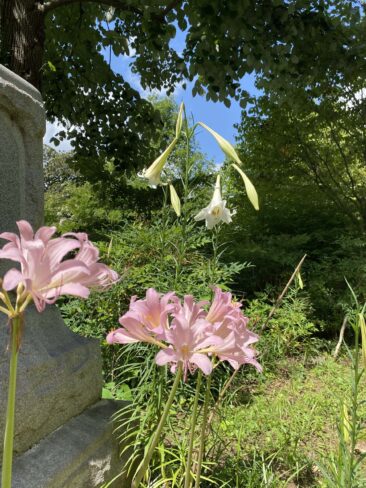
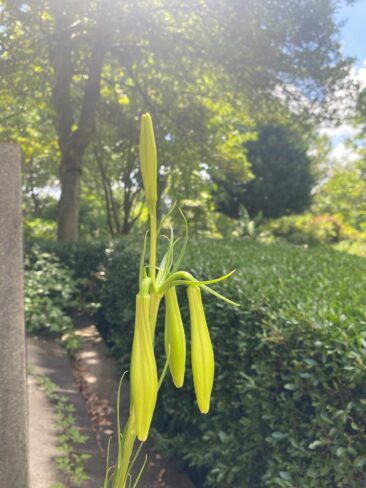
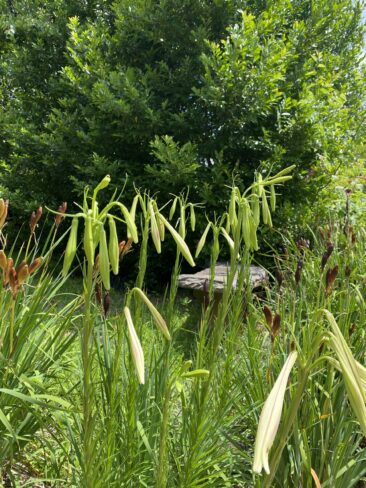
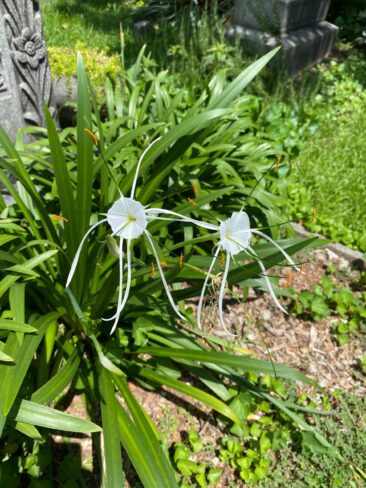
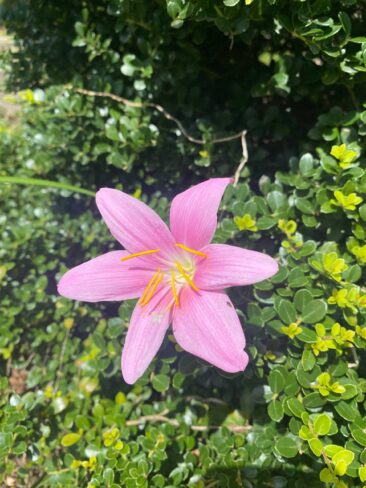
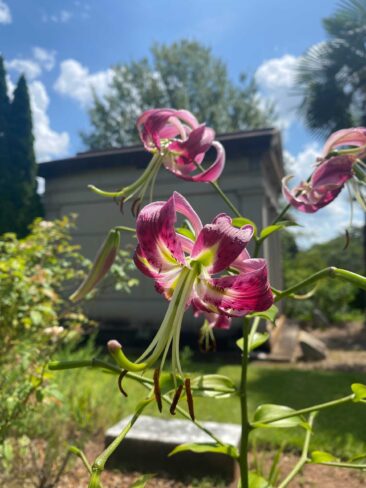
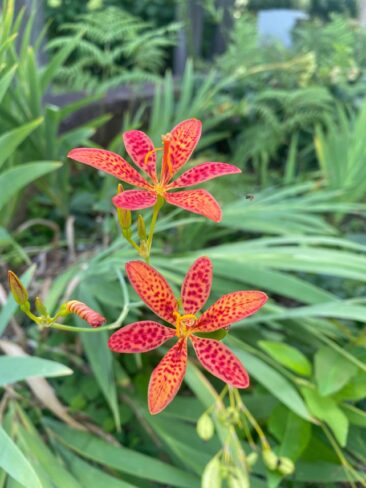
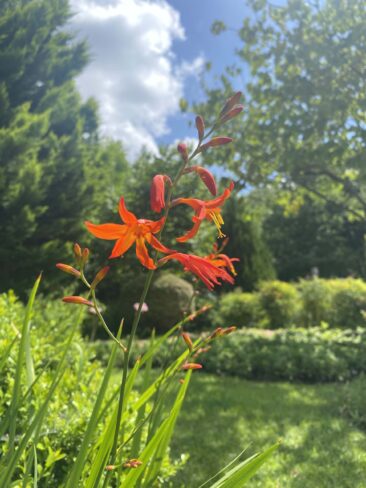
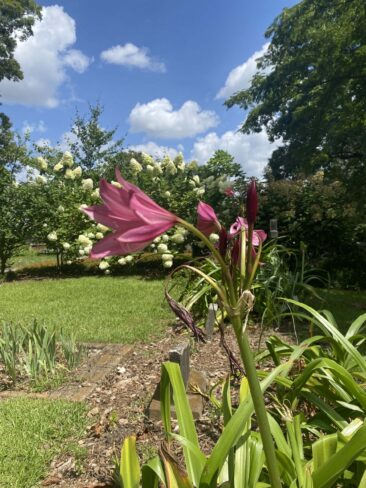
Leave a Reply